Black or white: What veil color should you wear to Mass?
Published on July 16, 2025
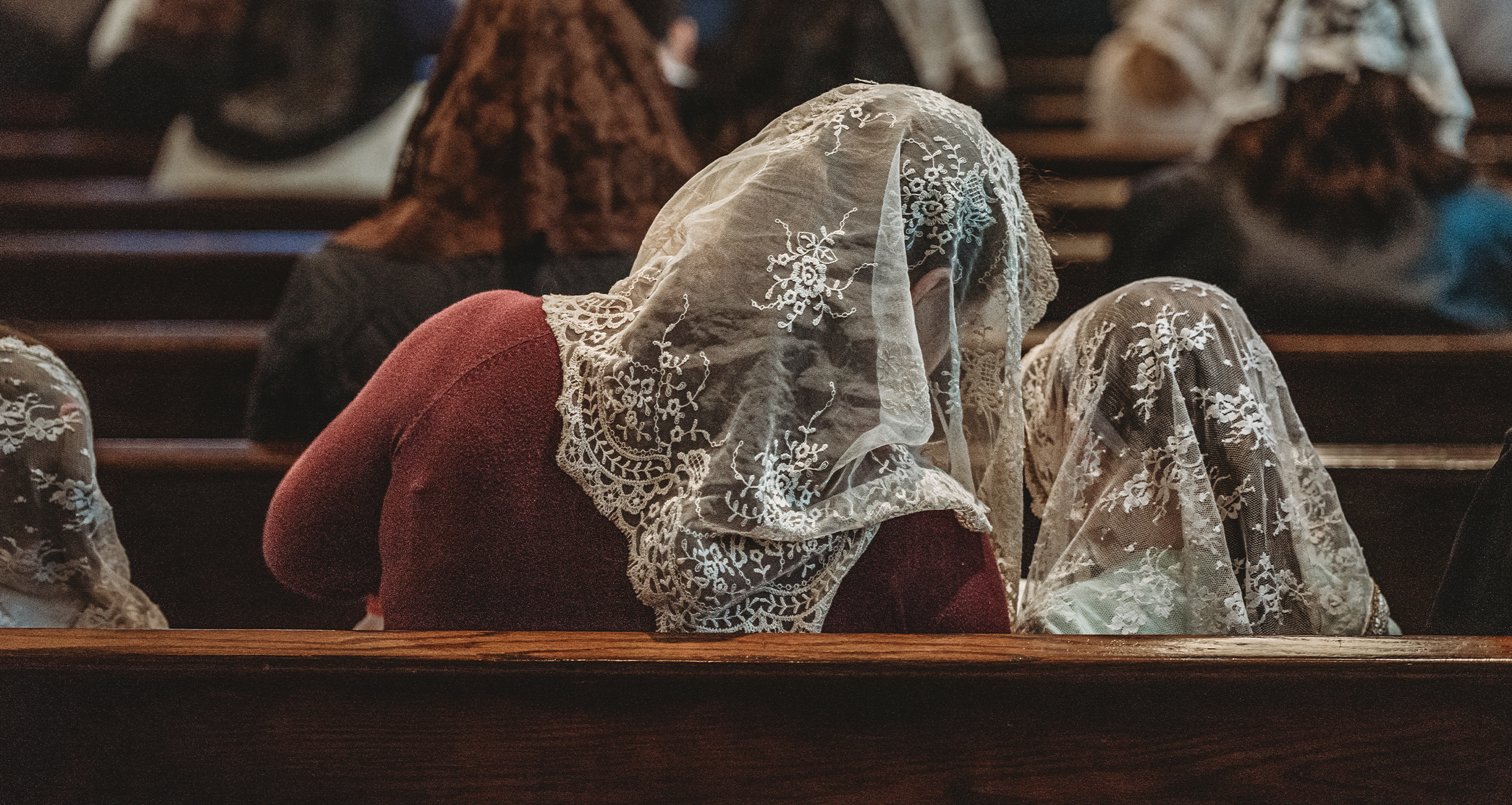
Today, more Catholic women are veiling at Mass than ever before. Controversial. Beautiful. Traditional. If you find yourself curious, turned off, or even confused about the practice of veiling, this one is for you.
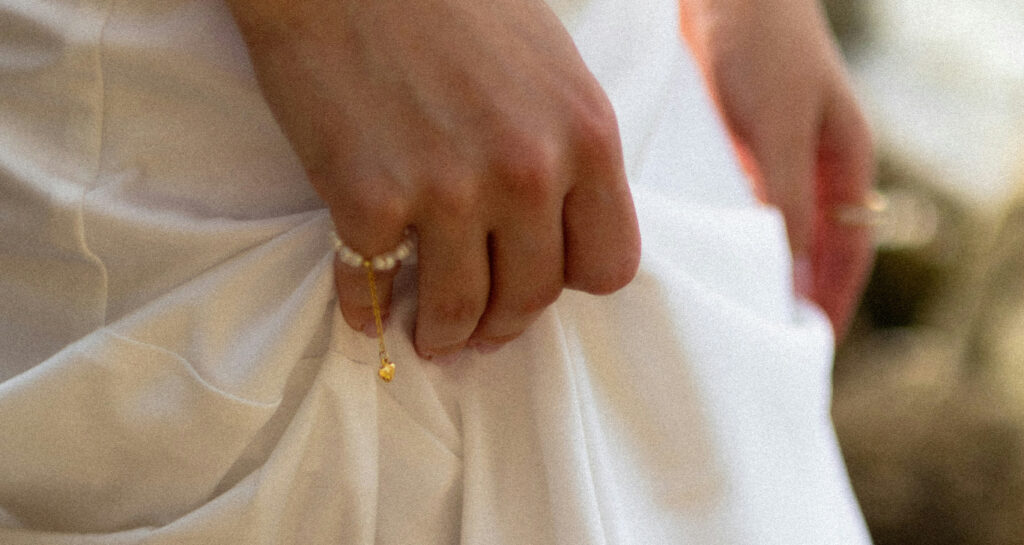
The dignity and honor of clothing
God was the first fashion designer, and his intention behind clothes was to restore our dignity lost through sin. After the fall, Adam and Eve were ashamed of their bodies. In his mercy, God gave them clothes to restore their dignity and remind them of their true identity as his son and daughter in Genesis 3:21.
Head coverings like a veil can do the same thing. When a bride veils on her wedding day and when a religious sister wears her veil, it signals their vocational commitment. A veil signals a woman’s dignity – she is “set apart” because of her beauty. God nurtures new life through her (physically as well as spiritually)!
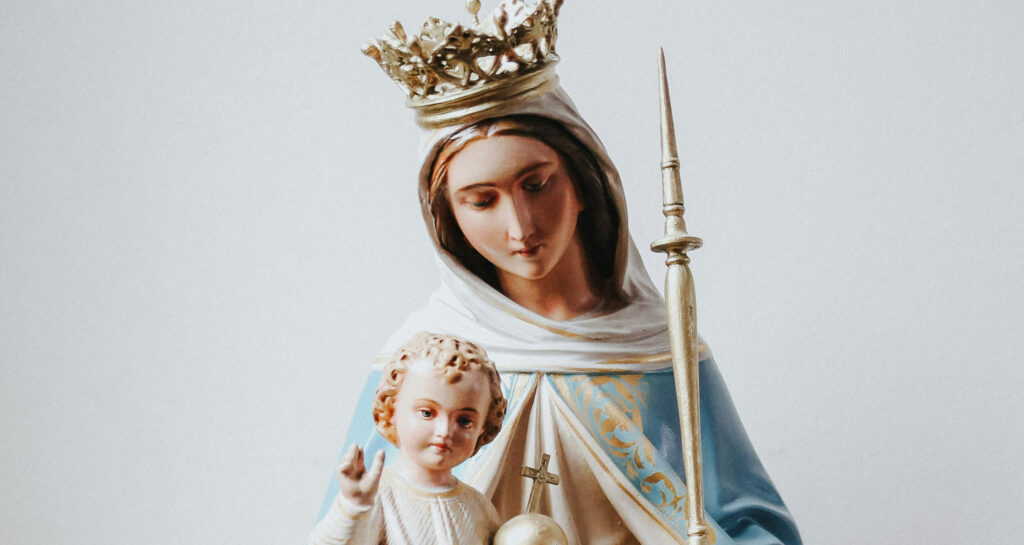
Emulating the most beautiful, perfect human?
The Virgin Mary also appears veiled in art. Her body is a temple of the Holy Spirit. and she is the Immaculate Conception who bears the God of the Universe. Her entire person, femininity, and essence is full of grace and sacred ground. Who wouldn’t want to emulate the most beautiful, perfect human?
When women veil, we enter in a small way into that Divine mystery, into the profound experience of original solitude where God is speaking directly to our hearts. We are beautiful, holy, sacred, and therefore, worthy of the veil because we belong to God.
Veiling at Mass is an outward sign that we obediently and freely submit to God out of humility, recognizing that He is King and Lord.
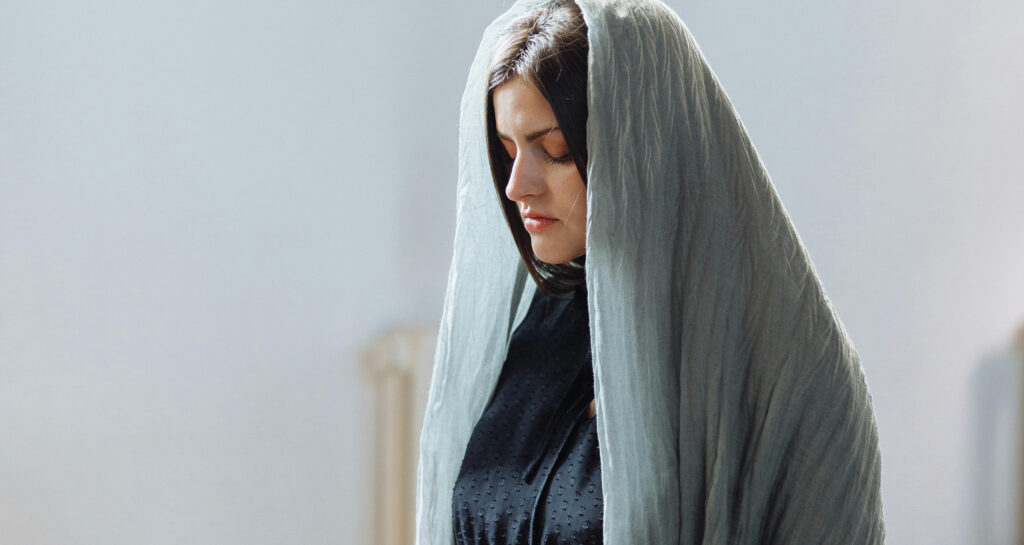
Sacred and life-giving
During the Mass, everything that is sacred is covered and hidden. The chalice that holds Jesus’ blood, a priest’s vestments, the altar, the tabernacle. Even in a procession, the monstrance goes forth under a canopy. Putting on a veil reaffirms the truth that God is the ultimate Bridegroom and we are His people. The wedding feast, and simultaneously Calvary, happens during the Holy sacrifice of the Mass, and women partake especially through veiling.
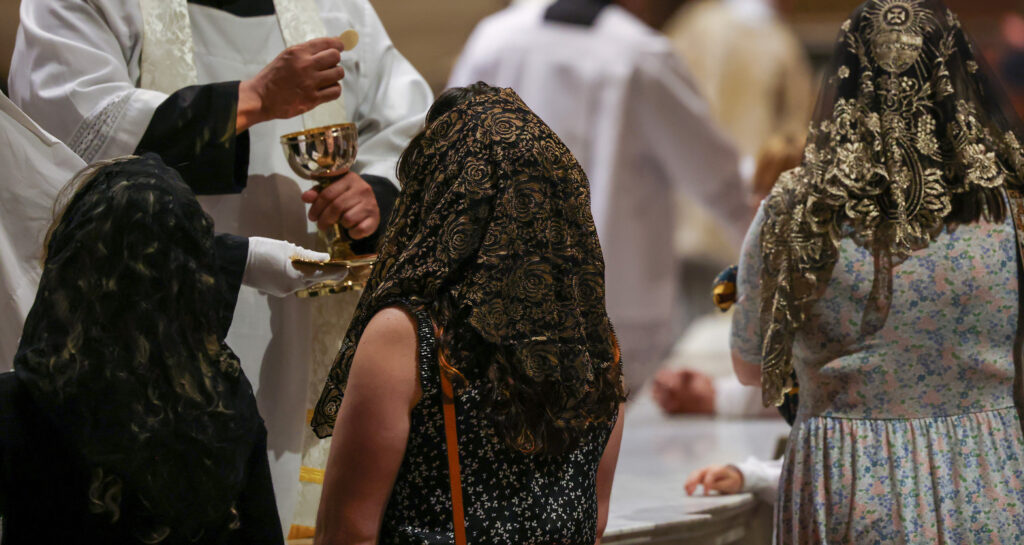
Before you veil
Chapel veils or mantillas derive from the meaning mantle or cloak. Wearing black veils as a married woman comes from Spanish, Italian and Latin American traditions.
Unmarried women traditionally wear white or lighter veil colors. If you’re at a wedding, however, avoid wearing a white veil out of respect for the bride.
To veil or not to veil? Biblically, there is no specific right answer, besides Paul telling the ladies to cover their heads. Veiling is completely voluntary and a personal decision.
Here are some considerations to see if it’s the right practice for you.
Judgements and opinions may come your way for wearing a veil. By veiling, you are making a statement. As explained earlier, veiling can become a good practice for bolstering your own self-worth, fear of God, and not caving in to what others think. If you have more questions, check out Veils by Lily’s FAQ page.
If your veil distracts you from Mass or draws your attention only to yourself, perhaps it’s not the time to start veiling. Not veiling isn’t sinful. It’s okay if you don’t feel called or comfortable to do so. Do what will best bring glory to God based on your own spiritual life and what comes up in prayer. Be not afraid.
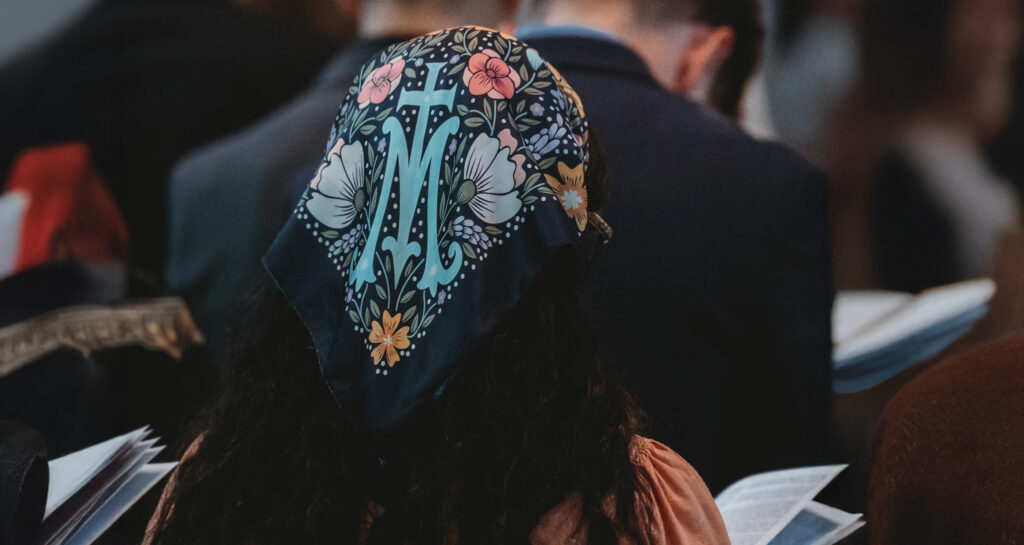
Veil color calendar
Depending on the feast day, you may see different veils of different colors. The more vibrant the color doesn’t always mean better. Veiling is about intention and your relationship with God, not color selection.
- Ordinary time – White and black veils are the standard.
- Marian feast days – Wear a deep blue or a soft blue to honor Her on Holy days of obligation or even First Saturdays.
- Advent & Lent – Try on dark purple for a pop of color or stick to classic black.

Ready to start veiling?
Check out Refine’s review of online veil stores!
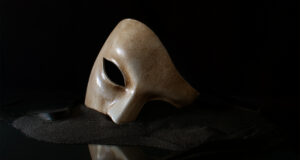

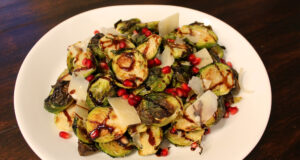

Good article! Best reason to veil is all of the above – ha. My confirmation name is Veronica and as I grew older, thinking about Veronica and how she wiped the face of Jesus with her veil, I thought too that I needed to veil to remind me to think of the many facets of living life and loving God.
I’m sorry, but this is going towards practices of Islam.
Not at all. It is just being reverent and prayerful. Nothing like sharia law.
Sue, my grandmother never entered the church unless her head was covered, either with a veil or hat. We were bayou people. My grandmother was born in 1884 and passed in 1977, she never knew anything about Islam. The practice of wearing a veil goes back all the way to the times before Christ. Islam began in 610 AD.
What primary source are you referring to with this argument? Veiling was something that was commonplace in ancient times, religiously and secularly.
Perhaps this comes from the image at the bottom of the article. Kind of looks like a hijab.
Yes it does. If you feel it adds to your reverence of God, that’s fine. I’m just concerned for our nation. Islam wants nothing more than for you to feel like you are doing by choice before they come in and make it mandatory in public. Part of the slow creep into our society. Heard of Mamtramck & Dearborn Michigan? The proposed Epic City in Josephine TX? And covering your head is just a start.
You should just stop. You’re certainly entitled to your opinions but your argument is weak.
The main reason (not referenced in this article) why women veil in the Catholic Church is because they are sacred tabernacles. Like the tabernacle at the altar which is veiled because it contains life, THE life of the world, so to a woman, all women, contain life within them. From my 4 year old daughter to my grandmother, I am reminded that God chose women to be the bearers of life, and they should all be held sacred in my eyes. The observance that the Chalice, the tabernacle, and the daughters of God all are veiled should not be lost on anyone.
Not just ancient times. Up until the early 1970’s. And still now in traditional Catholic Churches.
I remember my mother pinning a doily on my.head before church. It made me feel special and closer to Jesus.
No, it is not. Even Jesus covered His head in prayer as a reminder that the Father is above.
Thannks for sharing that important information. Since Jesus covered His head then all men should cover their heads too. I don’t really need a piece of cloth to remind me I’m in God’s presence .
islam requires women to veil in public. In the Catholic church, if you choose to veil, you just do it in the sanctuary of the church.
Women in the Catholic Church were veiling hundreds of years before Islam claimed to be a religion. Dear Sue, please check your history.💕
Clearly you know nothing about the practice. Are you even Catholic?
Ridiculous. Islam did not even exist when Catholic women wore veils in the early centuries.
They still wore them in US into the 1950-60s, and beyond in other countries.
Women wearing a veil of some form in Mass is not different than a man not wearing a hat at Mass. bTW gentlemen – leave those ridiculous (& disrespectful) baseball caps in your car!)
Our Blessed Mother is always veiled! All women of the time of Jesus were veiled. Veiling is the act of reverence towards God.
Islam didn’t exists until the 600’s, when one man decided he was a god, so NO, sorry Sue, it is not the practices of Islam.
There is a great podcast by Dr. Marshall Taylor regarding the veil that may give you a clearer understanding of what Veiling means.
Those of us who are Veiled are showing great respect for the presence of Jesus who is truly in our Church either exposed or in the Tabernacle.
Sue, that photo at the bottom is a wool scarf that lots of women in the Northern Tier of the US wear in the winter. Some of our older churches are cold in the winter. No HVAC.
I’m sorry, but you need to do some research.
Dr. Marshall Taylor or Fr. Chris Alar have a great episode about “VEILING”
I believe that Veiling is not just a Catholic Tradition, it is a tender expression of love and reverence for Our Lord Jesus Christ.
It’s rooted in Scripture and has been embraced for centuries. Veiling reflects the virtues of humility, modesty, and respect.
When we veil before The Eucharistic presence of Our Lord, we acknowledge His majesty and our place as His cherished daughters.
It is a quiet, intimate way to draw closer to Him, reminding us that we are in the presence of our King, surrendering our hearts with love and grace.
Bishop Strickland encouraged women to wear veils because he said it reminds all of us that we’re in a sacred place.
It does remind me that I’m in God’s presence, since that’s the only time I wear one.
I seesawed over this for a time because I was more concerned with what others would think especially since I don’t attend a TLM. Well, I felt a calling to this devotion, and I chose to focus on the LORD rather than what others would think of me because this outward devotion isn’t about them but my humility before our LORD when in HIS Presence. This devotion has deepened my participation during Holy Mass.
Before the 1970’s most all women in the Catholic community would not enter the church without a head covering. My Mom wore one until she passed in 2000
I veil to be humble in the presence of the Living God. It’s a deeply personal belief that I find hard to explain. For 10 years now, I have been the only woman to veil at Mass, or when I am within sight of the Tabernacle, at this church. Not even the nuns veil here!!
There are other churches nearby where women veil, but this is not about blending in or standing out. Jesus deserves the greatest respect I can offer, here, where I live.
I am humble in the presence of God with no head covering because my humility is from my heart.
Interestingly, women in East Asia tend to wear white veils when they choose to veil regardless of marital status. We experienced this while living in Japan and visiting South Korea and Thailand. I’m curious whether anyone who has visited Vietnam or other parts of Asia saw the same thing.
We sometimes go to mass with my mother-in-law at the Korean Catholic Church where many, many women veil- and they all wear white veils! I have to ask her why they wear white. Even she wears white and she’s widowed.
Before Vatican II , all women wore something on their head going to church be it a hat or a veil.
Yes I remember that and what we did if we forgot! Comical now! I veil because I believe Jesus asked me to. I did struggle with this for a while.
When I went to CCD classes and we went to Mass, if we forgot to bring our chapel veil, a sister would be standing at the church entrance with a box of Kleenex and a handful of Bobby pins. It was embarrasing to be the one with a tissue on your head – so you remembered to bring the little plastic case with your veil in it.
Yes. I remember my grade school days in the 60’s. We attended Mass as a class at least once a week and if we forgot our uniform beanie or scarf the teacher would give you a tissue or hanky to wear on your head. You did NOT want to be that girl. LOL.
I try to coordinate my veil color to best match what I am wearing.
When I was in grammar school, we always had to wear either a hat or veil every time we went to Church .
I have noticed that the women who veil usually (not always, especially girls) wear skirts or dresses any time they are at Mass, even daily Mass. This is a plus in my opinion.
It a sign of respect and adoration in the Presence of the Lord. I also wear a light sweater if my dress has short sleeves. Would you wear jeans or shorts or a tank top if you knew you were going to see Jesus? That is also why I wear a veil. It s my way of showing humility and devotion.
I was at a Novus Order Mass this Sunday (not my usual choice – I generally go to a TLM) and a family with four teenagers came in. The one girl had a skirt so short it was astonishing. She was two rows in front of me (no one in the row between) and when she bent to reach over to her father to give the Sign of the Peace, I could see literally everything. Everything- if she was wearing anything under that skirt it was a dental-floss thong that didn’t show AT ALL). I looked away immediately but wondered how her family could let her out the door like that, let alone to Church.
I believe the custom of veiling is beautiful! I distinctly remember wearing a round cover on our heads when we were in Church in Catholic school. The comment made about it seeming Islamic is nonsense.
Women veiling at Mass is a physical sign of the spiritual reality that Jesus, the Bridegroom is waiting for each of us at the altar. When I go to receive Him in Holy Communion, I come as bride.
When I first began veiling about 7 years ago, I did so because I felt God asking me to out of humility and honor of His presence. I was literally the only woman veiling in our parish. But then I realized that I really wasn’t alone. Our Blessed Mother was veiling with me! No one better to emulate. Now the devotion is becoming more commonplace. And I am not alone.
Growing up in the 1950s, we always covered our heads in church, though we were never involved in a lengthy discussion as to why. Just as appropriate clothing was how one showed outward respect, our head coverings were a further part of the package…sadly missing today for the most part. My observations about the article involve the somewhat mixed messaging. As it discusses reverence and humility as being reasons for veiling yet not wanting attention drawn to ourselves, it concludes by suggesting we consider choosing a veil with a “pop of color” for specific times of the church year. Earlier, the author suggests we not wear a white veil to a wedding “out of respect for the bride”, which takes away exactly who we are to be showing respect for. Seems a humbling and respectful practice gets lost in the weeds of the self, wondering “how do I look?”
I feel the “drawing attention to ourselves” would be the woman’s personal perspective. If you are doing something with the intention of garnering attention, then that’s wrong. If you are doing something with the intention of pleasing God, and being dressed appropriately, and that is your sole intention, then I don’t worry about what other people think. They have their own responsibility to control their minds.
For my entire 8 plus decades of life, I have always worn a head covering be it a hat or a mantilla when entering a Catholic Church. In my opinion, I am being humble and respectful in God’s Presence.
Can you share given the idea that we are sacred beings, why do women veil and not men?
As a recent convert, I wondered why some ppl wear a head covering. Thank you for the article
Welcome home! Enjoy your journey.
I started to veil about 2 years ago after my pastor encouraged us. I love wearing the veil in mass. However, I don’t veil in Vietnamese masses where no one veil so that I don’t distract others (I live in Orange County, CA.)
Beautiful easy to read and understand resource!
https://sophiainstitute.com/product/the-chapel-veil/
Fear of God – veil? I noticed that was suggested for reason to veil. I never felt comfortable placing a veil – I see many women fussing to keep the veil in place – for this and other reasons – I see no reason to veil. I do not feel diminished in any way – or less than – for not veiling. I wear brown scapular – pray the rosary – honor first Saturdays.
For me – it’s a distraction and again unnecessary. I see veiling as something that was once practiced like women wearing gloves to church – or altar servers wearing gloves at one time (and now most do not).
Thank you. I mostly see increased reverence and I welcome that. Last Sunday, however, the woman in front of us was veiled during mass. I was distracted because she kept touching, smoothing, rearranging her veil. She was also wearing a short sundress revealing ample cleavage. I was tempted to take the long ends of her mantilla and cover the exposed chest. Not all that glitters is gold.
I see veils paired with tight jeans and a t-shirt, and all I can think is “oxymoron.”
Veiling was both a Jewish and Christian tradition that far predated Islam, so what does veiling (in our sense) have to do with Islam?
A modest attitude and outfit is far more important than wether or not one wears a veil. I am often shocked by women who try to look “humble” in a veil while wearing super tight jeans, tank tops or sundresses that belong to the beach. So you don’t show your hair, but we have to see half of your breasts or the shape of your behind?
Others keep their veil on outside the church and talk and laugh very obnoxiously… not a modest demeanor either…